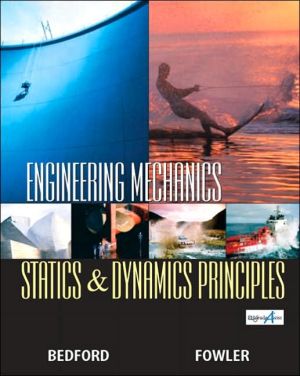

 |

|

Sold Out
Book Categories |
Statics
1. Introduction.
Engineering and Mechanics. Learning Mechanics. Fundamental Concepts. Units.
Vector Operations and Definitions. Scalars and Vectors. Rules for Manipulating Vectors. Cartesian Components. Components in Two Dimensions. Components in Three Dimensions. Products of Vectors. Dot Products. Cross Products. Mixed Triple Products.
Types of Forces. Equilibrium and Free-Body Diagrams. Two-Dimensional Force Systems. Three-Dimensional Force Systems.
Two-Dimensional Description of the Moment. The Moment Vector. Moment of a Force about a Line. Couples. Equivalent Systems. Representing Systems by Equivalent Systems.
The Equilibrium Equations. Two-Dimensional Applications. Statically Indeterminate Objects. Three-Dimensional Applications. Two-Force and Three-Force Members.
Trusses. The Method of Joints. The Method of Sections. Space Trusses. Frames and Machines.
Centroids. Centroids of Areas. Centroids of Composite Areas. Distributed Loads. Centroids of Volumes and Lines. The Pappus-Guldinus Theorems. Centers of Mass. Definition of the Center of Mass. Centers of Mass of Composite Objects.
Areas. Definitions. Parallel-Axis Theorems. Rotated and Principal Axes. Masses. Simple Objects. Parallel-Axis Theorem.
Theory of Dry Friction. Applications.
Beams. Axial Force, Shear Force, and Bending Moment. Shear Force and Bending Moment Diagrams. Relations between Distributed Load, Shear Force, and Bending Moment. Cables. Loads Distributed Uniformly Along Straight Lines. Loads Distributed Uniformly Along Cables. Discrete Loads. Liquids and Gases. Pressure and the Center of Pressure. Pressure in a Stationary Liquid.
Virtual Work. Potential Energy.
Engineering and Mechanics. Learning Mechanics. Fundamental Concepts. Units.
Position, Velocity, and Acceleration. Straight-Line Motion. Curvilinear Motion. Relative Motion.
Newton's Second Law. Equation of Motion for the Center at Mass. Inertial Reference Frames. Applications. Orbital Mechanics.
Work and Kinetic Energy. Principle of Work and Energy. Work and Power. Work Done by Particular Forces. Potential Energy Conservation of Energy. Conservative Forces.
Principle of Impulse and Momentum. Conservation of Linear Momentum. Impacts. Angular Momentum. Mass Flows.
Rigid Bodies and Types of Motion. Rotation about a Fixed Axis. General Motions: Velocities. General Motions: Accelerations. Sliding Contacts. Moving Reference Frames.
Preview of the Equations of Motion. Momentum Principles for a System of Particles. Derivation of the Equations of Motion. Applications. Appendix: Moments of Inertia.
Principle of Work and Energy. Work and Potential Energy. Power. Principles of Impulse and Momentum. Impacts.
Kinematics. Angular Momentum. Moments and Products of Inertia. Euler's Equations. Eulerian Angles.
Conservative Systems. Damped Vibrations. Forced Vibrations.
Login|Complaints|Blog|Games|Digital Media|Souls|Obituary|Contact Us|FAQ
CAN'T FIND WHAT YOU'RE LOOKING FOR? CLICK HERE!!! X
 You must be logged in to add to WishlistX
 This item is in your Wish ListX
 This item is in your CollectionEngineering Mechanics-Statics and Dynamics Principles Statics & Dynamics Principles
X
 This Item is in Your InventoryEngineering Mechanics-Statics and Dynamics Principles Statics & Dynamics Principles
X
 You must be logged in to review the productsX
 X
 X

Add Engineering Mechanics-Statics and Dynamics Principles Statics & Dynamics Principles, More than just a book, this volume is part of a system to teach engineering mechanics, a system comprised of three components: 1) this core principles book, 2) algorithmic problem material available online, and 3) a course management system to track and m, Engineering Mechanics-Statics and Dynamics Principles Statics & Dynamics Principles to the inventory that you are selling on WonderClubX
 X

Add Engineering Mechanics-Statics and Dynamics Principles Statics & Dynamics Principles, More than just a book, this volume is part of a system to teach engineering mechanics, a system comprised of three components: 1) this core principles book, 2) algorithmic problem material available online, and 3) a course management system to track and m, Engineering Mechanics-Statics and Dynamics Principles Statics & Dynamics Principles to your collection on WonderClub |